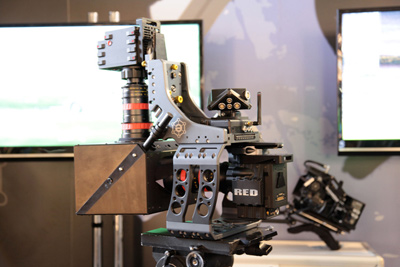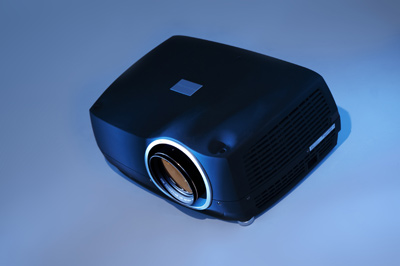As the annual trade show at Amsterdam's RAI conference center comes to a close, new products get ready to launch on the world market
Cinedeck, going the other route, has put more into its latest portable DDR, Cinedeck EXTREME v2.0, to please a discriminating higher-end market but also to spread its appeal across the wider mid-level of production and post. Taking a page from the Ki Pro, the Cinedeck recorder now includes Apple ProRes support, as well as Avid DNxHD and CineForm Uncompressed, for single- or dual-link recording. But in addition to the EXTREME’s built-in monitor, there’s now an uncompressed HD 4:4:4 recording option (an extra $2,995) that does Ki Pro one step better. There’s also a new optional EXSync module ($795), coming in October, that will let DPs sync one or more EXTREMEs to SMPTE timecode. New Cinedeck CEO Alan Hoff told me that those features are critical when shooting stereo 3D or regular 2D with cameras like ARRI’s ALEXA and Sony’s F35. It’s much more expensive than the Ki Pro as a result, retailing for around $10,000.
More portable options came from Globalstor, who announced that it had miniaturized its ExtremeStor-DI workstations to a portable model for on-set dailies and screenings. The rugged box, on display in Assimilate’s booth during the show, has a 17-inch 1920×1080 display and optional dual RED Rocket card slots for stereo Red R3D playback.
When going on-location, portability is meaningless without extended battery power. Anton Bauer showed a range of batteries, including the brand new Dionic HCX, which it was showing in the booth attached to an ARRI ALEXA. The HCX has a handy automatic “deep sleep” mode, which clicks on after two weeks on the shelf and extends its battery life (lithium-ion batteries shed a lot of charge just sitting there doing nothing, apparently). The two-pound battery wakes back up again when you pick it up and get ready to load it, thanks to an on-board motion detector.
Anton Bauer was also showing its Gold Mount bracket option, which mounts to HD DSLR shoulder rigs like those from Redrock and Zacuto. Interestingly, the American love affair with HD DSLR hasn’t really crossed the pond with the same intensity, though there have been several extraordinary project examples from European early adopters.
3D Comes of Age
Most of the 3D gear and software on display at IBC made its first appearance at NAB, though there were a few notable exceptions. Element Technica premiered its 3D Pulsar rig and announced that its smaller Neutron rig, which it debuted at NAB, was now shipping. The family of rigs, anchored by the Quasar 3D rig that was first introduced at IBC last year, are particularly suited to RED cameras. The company showed what it believes were the only pair of RED EPICs and RED SCARLETs mounted to stereo rigs at the show. The EPICs are mounted to the new Pulsar rig and SCARLETs to the Neutron rig.

An EPIC mounted on Element Technica’s new 3D Pulsar rig
Element Technica has been making accessories for RED cameras since the earliest RED ONE and is following what it says is a rising demand for shooting in stereo, particularly with RED. Many other manufacturers I spoke with during the show also noted this trend.
Norway’s projectiondesign announced its new stereoscopic 3D projector, the cineo35 3D, aimed at preview suites and collaborative finishing. With full-bandwidth, uncompressed HD resolution, 3G SDI and HDMI/Dual Link DVI inputs, the projector displays stereoscopic content at up to 330 MHz pixel rates.
The company also unveiled the cineo35 2.5k, arguably the first compact projector that can project images at up to 2560 x 1600 native resolution. Why does that matter? Unlike regular 1080p projectors, this new display won’t crop or scale your original 2K images. Better yet, there is still room on the screen for editing and color-correction tools to tweak in real time while you’re looking at the footage. The cineo35 2.5k will be available in both a lamp-based and LED version.

The cineo35 2.5k from projectiondesign
Sony showed its now-shipping 3D Box, a 2D-to-3D converter and 3D graphics generator that helped the World Cup go 3D, as well as 3D monitors, an upgraded MVS-8000X switcher (with 3G connectivity) and Sony Vegas Pro 10, now the only editing software that lets you natively edit stereo 3D without a plug-in. The biggest news from Sony, during a press conference the first day of the show, was the unveiling of two prototypes: a new 3D camcorder in a single camera housing, like Panasonic’s 3DA1, and a 35 mm digital camcorder with a 35 mm sensor. For a closer look on all of the above, watch the video below. You’ll also hear more about upgrades to the F35 and the new SxS card-based PMW-500, which StudioDaily covered at its simultaneous New York introduction. Read more about that here.
Speaking of SxS cards, Sonnet showed an SxS reader that it is adding to its popular Qio line of universal readers. The Qio E3, coming in November for $599, is a three-slot SxS reader that doubles as a three-slot bus expansion for ExpressCard/34 adapters. Sonnet also announced the Fusion RX1600 Vfibre, an expandable 16-drive RAID video editing SAN server that combines Fibre Channel and Gigabit Ethernet connectivity for 4K workflows or collaborative environments. Expect it sometime later this year in either 16TB or 32TB versions.
Plenty of people at IBC were talking about “the cloud,” particularly Front Porch Digital, which unveiled DIVApublish, the last piece of its ingest, media management and archiving pipeline that pushes content to the cloud for automatic distribution from the edit suite on out to mobile devices, game consoles, the Web and video-on-demand. In a direct play for Ooyala and Bright Cove market share, Front Porch Digital’s CEO Mike Knaisch said the new offering automatically converts content into metadata-rich files, giving content creators more control, at the granular level, of every bit of content across their organizations. In beta right now, DIVApublish will be available in Q2 2011.

Sections: Business Technology
Did you enjoy this article? Sign up to receive the StudioDaily Fix eletter containing the latest stories, including news, videos, interviews, reviews and more.